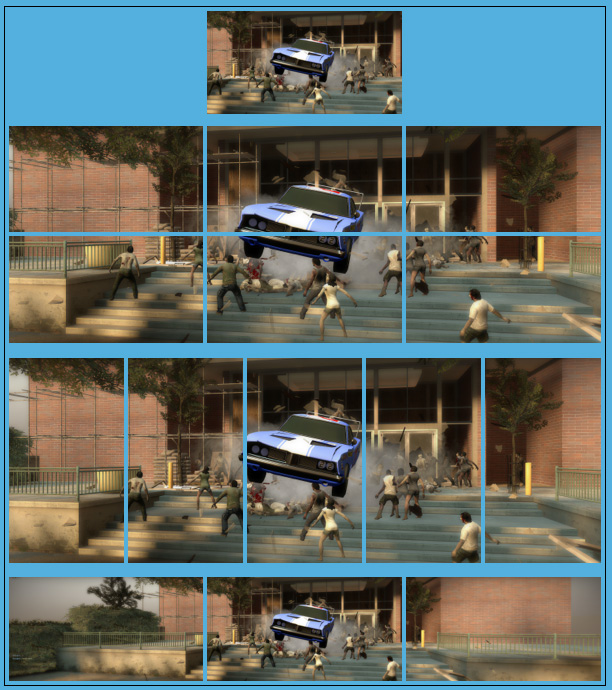AMD Eyefinity 5x1-Portrait Review
The Catalyst driver suite 10.12 brought support for 5x1-Portrait Eyefinity. This feature has been a long time coming, with users desiring this update for over a year. The info below is summarized from my original Radeon HD 5870 Eyefinity6 Review.
Immersion by Aspect Ratio
Traditionally, 3x1 landscape (3x1-L) has offered a clear sense of immersion over a single widescreen display. It is easy to see the increase aspect ratio offered by three displays, and the increased field of vision when a game properly supports that aspect ratio through “Hor+” or “Pixel based” behavior.
The one area lacking in a 3x1-L implementation is the physical height of the monitors. Most gamers end up with 3x22” or 3x24” monitors, which have an average height of 12” - 14”. While the 3x1-L setup extends to the users’ horizontal periphery, the vertical field of vision still includes objects and items other than the monitor.
Immersion by Physical Size
Many detractors of Eyefinity gaming would offer a statement such as, “I’d rather just buy a 50” HDTV and game off of that.” Point taken. However, your 50” TV only has a resolution of 1920x1080. And, that TV is probably sitting 12-18 feet away from you across your living room. If said user sat 2-3 feet from said HDTV, they could easily count the 2,073,000 pixels staring at them and be treated to a nice dose of the “screen door” effect.
Below is a table of current and future options (arranged by increased FOV). Using 16:10 monitors would produce slightly different results - such as slightly narrower aspect in 3x2, and slightly wider aspect in 5x1-P.
| 16:9 Monitor Config | Resolution | Aspect Ratio | Normalized Aspect Ratio | Field of Vision | Total Pixels |
| 3x1 Portrait | 3240x1920 | 27:16 | 16:9.5 | 87 | 6.2M |
| Single Widescreen | 1920x1080 | 16:9 | 16:9 | 90 | 2.1M |
| 3x2 Landscape | 5760x2160 | 16:6 | 16:6 | 113 | 12.4M |
| 5x1 Portrait | 5400x1920 | 45:16 | 16:5.7 | 115 | 10.4M |
| 3x1 Landscape | 5760x1080 | 16:3 | 16:3 | 143 | 6.2M |
| 5 x 4:3 (1600x1200) | 8000x1200 | 20:3 | 16:2.4 | 150 | 9.6M |
| 5x1 Landscale (1600x900) | 8000x900 | 80:9 | 16:1.8 | 157 | 7.2M |
Balancing Aspect & Physical Size
Physically, five monitors in portrait mode is right at the same width as three panels in landscape. Thus, your horizontal peripheral vision is filled. The portrait configuration also ensures that the vertical peripheral vision is filled as well.
I didn’t think I would be a fan of the portrait configuration, and was surprised to find that 3x1-P was Kyle Bennet’s (of HardOCP) preferred setup with the original HD 5870. I have five panels in portrait configuration, and since I’ve been benchmarking the 3x1-P configuration I can see why Kyle preferred this option. Though it isn’t to everyone’s taste, it does have its benefits.
Below is a comparison of the same scene as viewed through different Eyefinity options.

While less than the traditional 3x1-L aspect (of approximately 16:3.2), the 5x1-P implementation of 16:5.5 offers obvious enhancements over 16:9 or 16:10. Personally, I see 5x1-P as the perfect balance for physical and aspect immersion, for the following reasons:
- Physically fills the field of vision - both horizontally and vertically.
- It offers a significantly increased aspect ratio over “normal” widescreen
- Due to a less “extreme” aspect ratio, it would suffer less “edge distortion” than 3x1-L.
- Doesn't have the horizontal bezels of 3x2 Eyefinity
- If a game doesn’t support ultra-wide aspect ratios, you could still play in “widescreen” on 3x1-P, at an ultra-high resolution (rather than a single small widescreen).
- Games that “break” in ultra-wide aspect ratios (i.e., disappearing objects in Dragon Age: Origins, broken cinematics in The Witcher, etc.) may function normally in a less extreme aspect ratio.
The images and data for the table were pulled using the new WSGF FOV and Aspect Ratio Calculator created by forum member Delphium. The tool is a great update to our original FOV tool, and provides a wealth of information. Thanks for all of his hard work on this excellent tool.
Specifications
As of today, 5x1-P is only supported on the "legacy" Radeon HD 5870 Eyefinity6 card. AMD does have future parts in the works to support 5 panel setups within the 6900 series. Included below are the specs for the E6 card, along with the newer 6000-series.
| Card | GPUs | Transistors | Max Memory | Shaders | Clock (MHz) | TDP (Watts) | MSRP* | ||
| Core | Mem | Idle | Max | ||||||
| AMD Radeon HD 6970 | 1 | 2.6B | 2GB | 1536 | 880 | 1350 | 20 | 250* | $369 |
| AMD Radeon HD 6950 | 1 | 2.6B | 2GB | 1408 | 800 | 1250 | 20 | 200* | $299 |
| AMD Radeon HD 6870 | 1 | 1.8B | 1GB | 1120 | 900 | 1050 | 19 | 151 | $239 |
| AMD Radeon HD 6850 | 1 | 1.8B | 1GB | 960 | 775 | 1000 | 19 | 127 | $179 |
| ATI Radeon HD 5870 E6 | 1 | 2.15B | 2GB | 1600 | 850 | 1200 | 34 | 228 | $399 |
| *These values represent the maximum wattage allowed through the AMD PowerTune. AMD estimates the average wattage draw for gaming is 190W/140W for the 6970/6950, respectively. |
|||||||||
